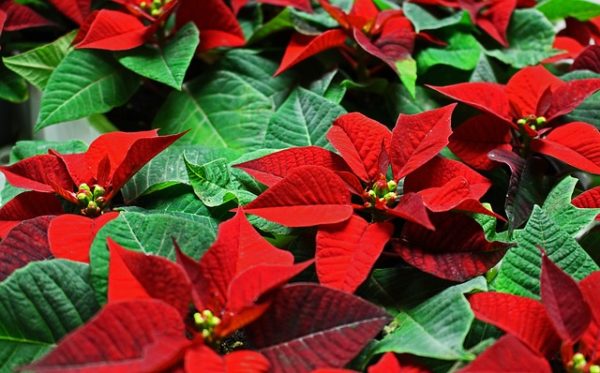The festive poinsettia is one of the most recognizable decorations of the Christmas season. Most often seen in bright red, there are also white, pink, and marbled varieties. The colorful parts of the plant are not actually petals or leaves, but are known as bracts. They provide a rich contrast with the poinsettia’s dark green leaves. If your holiday decor includes this traditional plant, you might be wondering, what is the history of the poinsettia? How long can they last? And are they poisonous?
 Poinsettias are native to Central America and southern Mexico, where they were cultivated by the Aztecs who called them cuetlaxochitl. Long before Europeans colonized the Americas, the Aztecs used the plant for dyes and medicinal purposes. In 1825, Joel Roberts Poinsett of South Carolina introduced the plant to the United States. Poinsett had been serving as an ambassador to Mexico when he saw the plants, and he brought a few cuttings back with him to grow on his plantation. Poinsett shared the plants with horticulturalists in other states, and their popularity grew. Meanwhile, the association between poinsettias and Christmas can be traced back to post-conquest Mexico, where poinsettias figure in several stories of Christmas miracles.
Poinsettias are native to Central America and southern Mexico, where they were cultivated by the Aztecs who called them cuetlaxochitl. Long before Europeans colonized the Americas, the Aztecs used the plant for dyes and medicinal purposes. In 1825, Joel Roberts Poinsett of South Carolina introduced the plant to the United States. Poinsett had been serving as an ambassador to Mexico when he saw the plants, and he brought a few cuttings back with him to grow on his plantation. Poinsett shared the plants with horticulturalists in other states, and their popularity grew. Meanwhile, the association between poinsettias and Christmas can be traced back to post-conquest Mexico, where poinsettias figure in several stories of Christmas miracles.
If properly cared for, potted poinsettia plants can last well beyond the holiday season. The Colorado State University (CSU) Extension suggests keeping poinsettias in an area with at least six hours bright sunlight during the day. However, it is best to avoid actually placing the plants in direct sunlight, as this can cause their color to fade. The ideal temperature for poinsettias is 67-70° F during the daytime, and around 60° F at night. Avoid temperatures below 50° F. Poinsettia plants need moist soil, so can be watered any time the soil feels dry. Poinsettias in clay pots will need to be watered more frequently than those in plastic pots. If you plan on keeping the plants beyond the holiday season, CSU suggests adding fertilizer about once a month to encourage new blooms. Plants can also be kept for reflowering next year – for step-by-step instructions, see CSU’s Poinsettias fact sheet.
For many years, poinsettias were thought to be poisonous. However, more recent research has shown that poinsettias are in fact not poisonous – but still should not be eaten. To avoid upset tummies, CSU recommends keeping the plants out of reach of pets and small children.
For more on poinsettias, or to ask a plant-related question, visit the CSU Extension’s PlantTalk website.
Happy Holidays from the State Publications Library!
- How to Spot the Differences Between Eagles and Hawks - August 16, 2021
- How Transportation Projects Help Tell the Story of Colorado’s Past - August 9, 2021
- Time Machine Tuesday: The Night the Castlewood Canyon Dam Gave Way - August 3, 2021
